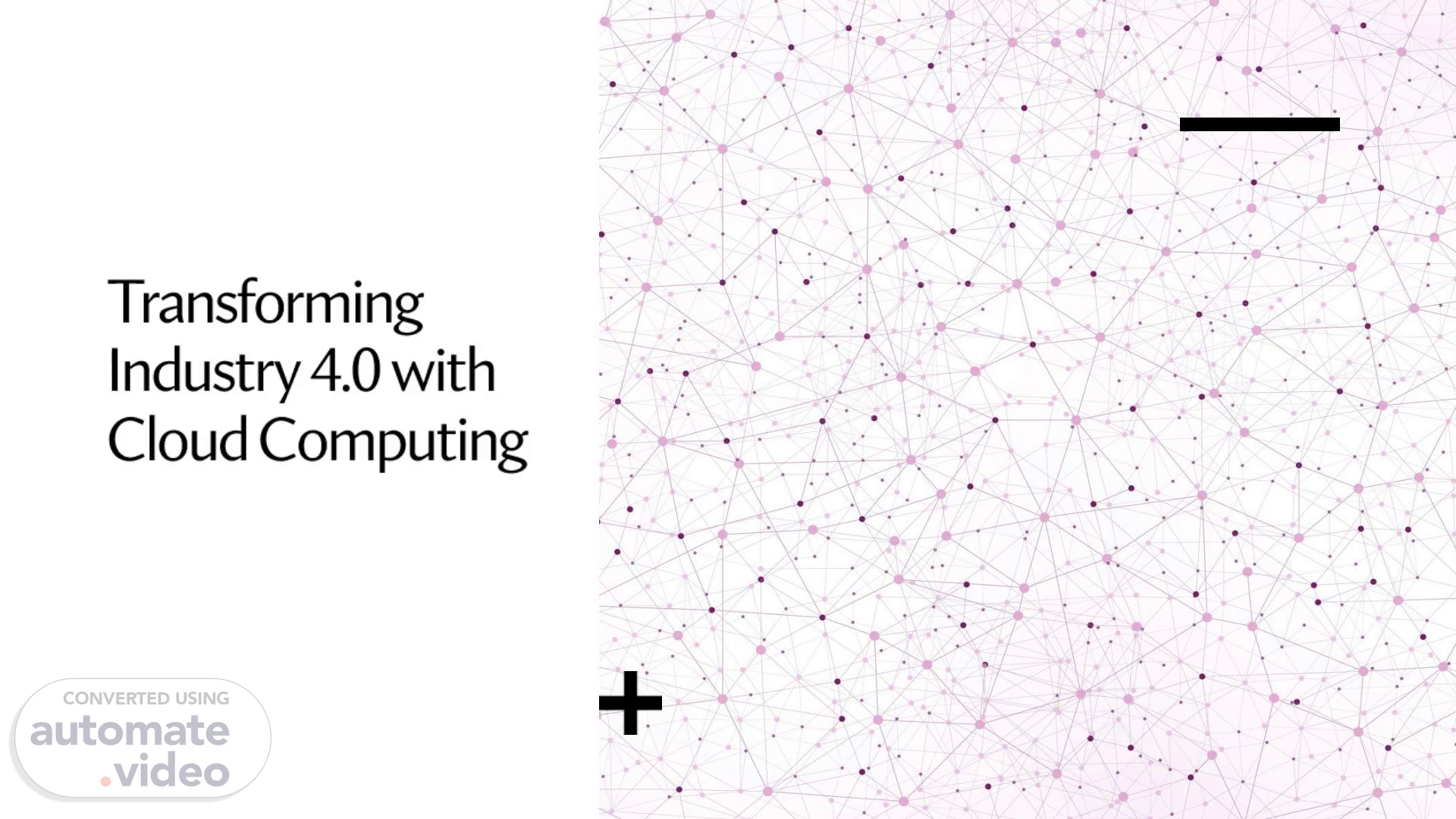
Page 1 (0s)
Transforming Industry 4.0 with Cloud Computing.
Page 2 (7s)
Introduction to Industry 4.0. Industry 4.0 - also called the Fourth Industrial Revolution or 4IR - is the next phase in the digitization of the manufacturing sector, driven by disruptive trends including the rise of data and connectivity, analytics, human-machine interaction, and improvements in robotics. Characterized by increasing automation and the employment of smart machines and smart factories, informed data helps to produce goods more efficiently and productively across the value chain. Technologies driving Industry 4.0: Cloud Computing Internet of Things (IoT) Artificial Intelligence Augmented Reality Cybersecurity Edge Computing.
Page 3 (33s)
Introduction to Cloud Computing. Cloud computing is the use of hardware and software to deliver a service over a network which is usually the internet. Email service providers such as Google Gmail and Microsoft Outlook are examples of using cloud computing to store messages. Businesses leverage IaaS providers like Amazon Web Services (AWS) and Microsoft Azure for scalable and on-demand computing resources, eliminating the need for extensive physical infrastructure. This is also called as Infrastructure as a service (IaaS). Cloud computing plays a significant role in Industry 4.0 by providing a scalable and flexible platform for storing, processing, and analysing the vast amounts of data generated by IoT devices and other industrial systems. The use of cloud computing in Industry 4.0 can help companies to improve efficiency, reduce costs, and increase competitiveness. One of the most important applications of cloud computing is its role in extensive data analysis. The extremely large volume of big data makes it impossible to store using traditional data management systems. Due to the very high storage capacity of the cloud, businesses can now store and analyse big data to gain valuable business insights..
Page 4 (1m 19s)
Scope of Cloud Computing on Project Management. In the current project management paradigm, issues like data fragmentation, limited collaboration, and accessibility constraints hinder efficiency. The vision for Cloud Computing in project management encompasses a future where teams experience enhanced collaboration through real-time document sharing and seamless communication tools. Scalability and resource optimization enable projects to adapt dynamically to changing demands, optimizing costs and improving efficiency. Centralized data management emerges as a solution to the problem of fragmented data storage, providing a single source of truth for project information. Real-time analytics, streamlined project planning, and integration with existing tools further contribute to a paradigm shift. Cloud Computing brings immediate benefits, creating a sustained acceleration towards more agile, collaborative, and successful project management practices..
Page 5 (1m 52s)
Current State of Cloud Computing in Project Management.
Page 6 (2m 40s)
Need for changes from current state. The need to revolutionize Cloud Computing for Industry 4.0 arises from the evolving demands and complexities of modern industrial processes. Industry 4.0 represents a paradigm shift towards smart, interconnected systems that leverage advanced technologies such as the Internet of Things (IoT), artificial intelligence, big data, and automation. Changes are required to meet the following needs: Scalability and Flexibility: Applications operating on Industry 4.0 must evolve to offer scalable and flexible solutions to handle large volume, variety and velocity of data. Data Security and Privacy: With the proliferation of connected devices, ensuring the security and privacy of sensitive data becomes paramount. Revolutionizing Cloud Computing involves implementing advanced security measures to safeguard data across the entire Industry 4.0 ecosystem. Interoperability: Industry 4.0 systems often comprise a diverse range of devices and technologies. Cloud services need to evolve to ensure seamless interoperability between different components, enabling smooth communication and collaboration. Cost-Efficiency: As Industry 4.0 adoption increases, ensuring cost-effective cloud solutions becomes crucial. Evolving Cloud Computing for Industry 4.0 involves optimizing costs and resource utilization to make these technologies accessible to a broader range of businesses..
Page 7 (3m 30s)
Hindrances. Several factors are currently hindering the widespread adoption of revolutionary changes in Cloud Computing for Industry 4.0. These challenges can be multifaceted and interconnected: Legacy Systems and Infrastructure: Many industries still rely on legacy systems that were not designed for the level of connectivity and data processing required by Industry 4.0. The cost and complexity of transitioning from these systems act as a significant barrier. Lack of Standardization: The absence of standardized protocols and frameworks for Industry 4.0 hampers interoperability between devices, systems, and cloud platforms. This lack of standardization makes it challenging to implement cohesive and integrated solutions. Lack of Human Resource: The rapid evolution of technology requires a skilled workforce to manage and implement advanced cloud solutions. A shortage of professionals with expertise in cloud technologies, data analytics, and cybersecurity poses a significant challenge for organizations looking to adopt Industry 4.0 practices. Change Management: Industry 4.0 isn’t limited to the shop floor - manufacturers need to establish an organization wide understanding of which departments need to coordinate to conduct successful Industry 4.0 pilots and broader rollouts. That requires new ways of working that differ from longstanding processes..
Page 8 (4m 19s)
8-steps for integration new changes in Cloud Computing to Industry 4.0.